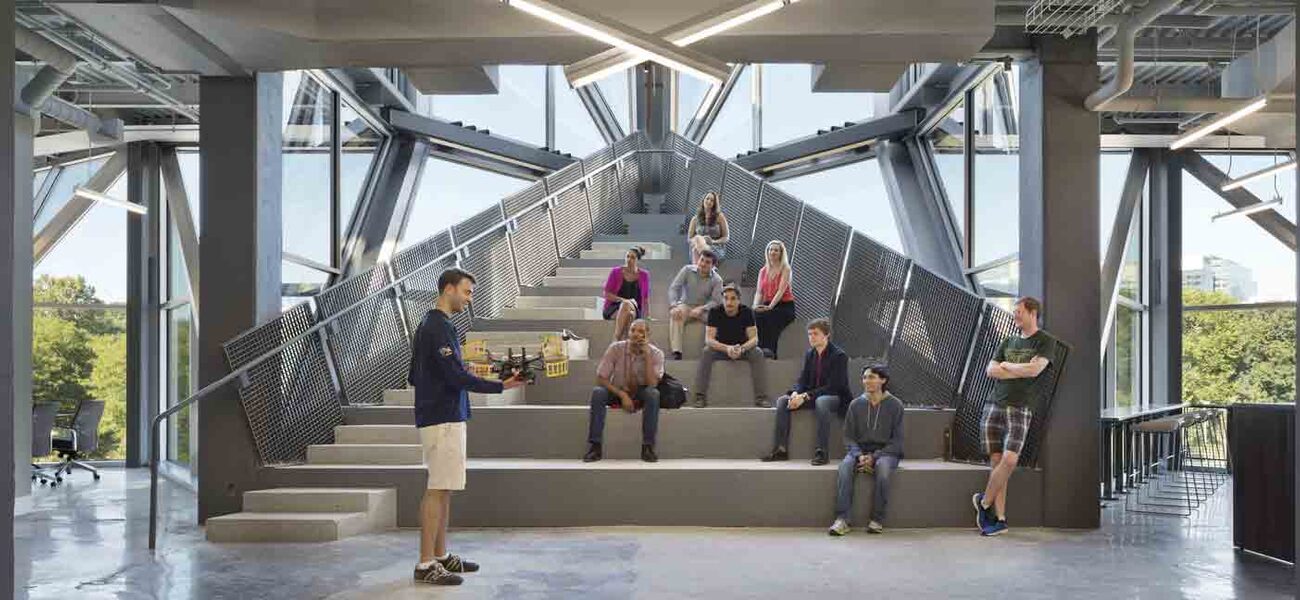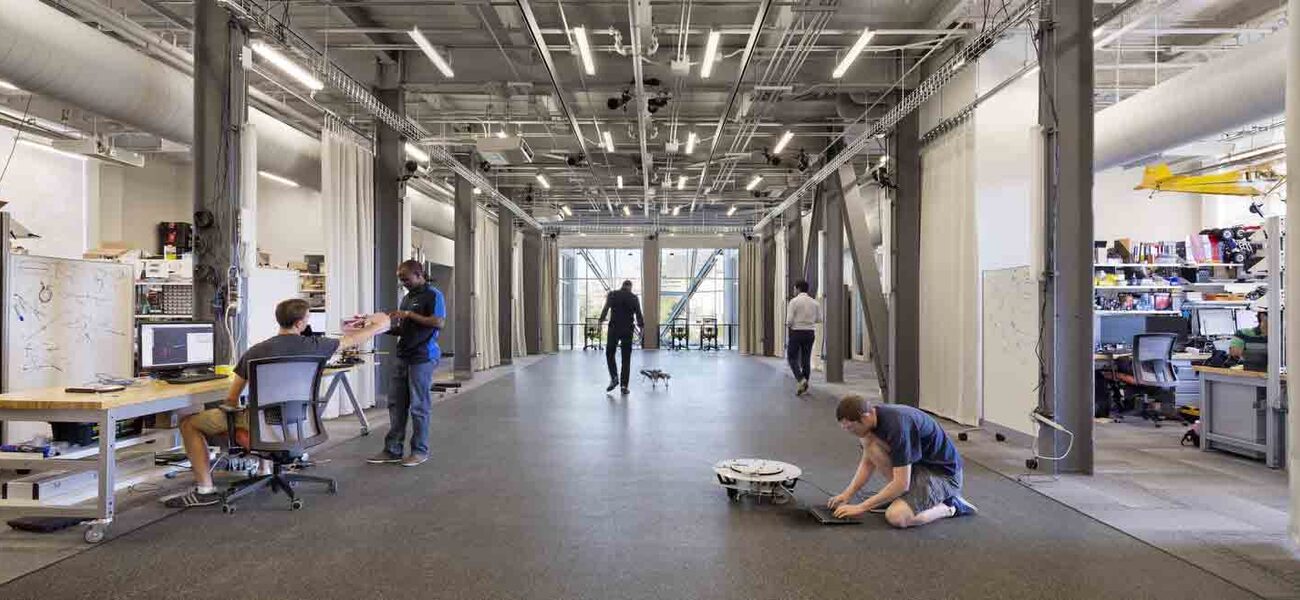Innovation hubs and incubators are emerging as the best solution to help universities, entrepreneurs, researchers, and students transform their creative ideas into viable commercial ventures. Users want facilities that focus on entrepreneurship, creativity, and innovation; foster interdisciplinary collaboration and partnerships; offer responsive and flexible spaces; create a spirit of ground-up innovation; support commercialization of ideas/products; and connect to nearby universities, companies, and amenities.
“Innovation centers are not about space, but about the ecosystem they offer and the functionality of the facility,” says Paul Sehnert, director of real estate development at the University of Pennsylvania in Philadelphia. “Startups seek proximity to educated workers, who are typically at research institutions, and access to their energy, ideas, and connections to professors. These hubs provide other important services, such as mentoring, shared equipment, administrative support, access to capital resources, and meeting spaces.”
The ecosystem reflects a diverse mix of tenants, with an enticing environment of creativity and interdisciplinary collaboration—the type of space that easily attracts users who are willing to pay for occupancy in the building. Tenants include a cross section of research types with overlapping areas of inquiry. These environments work best when researchers, entrepreneurs, and startups are open about their ideas and not yet in a development stage where intellectual property protection is the primary focus.
Many innovation centers use a curated community model, where they are selective about the startups and entrepreneurs who can use their facility after completing an application process. This contrasts with the coworking model, where any entity that pays can use space in a facility.
“Location, amenities, and a stimulating space all make the community more desirable, creating a larger pool of applicants to draw better qualified members from,” says Stephen Bartlett, associate principal at the architecture/engineering firm Ballinger. “Successful facilities have waiting lists and turn down applicants.”
The curated community makes members feel like they are working at the center of the world with key amenities and connections around them. They enjoy having a sense of purpose by observing rituals specific to a facility and feeling a sense of identity through membership. At the Pagliuca Life Lab at Harvard University, for example, anyone who has an epiphany in their work or accomplishes something as simple as fixing the printers can alert others in the building by hitting a gong.
A successful innovation center provides events and outreach activities to create a socially and intellectually stimulating environment that is particularly attractive to millennials. The changing demographics of the millennial workforce have contributed to the rise of innovation centers and incubators. Other factors fueling the increase are corporations seeking to partner with startups and access university talent, and higher education trends in research, development, and commercialization.
“The trend is to acquire promising startup firms with research and development already under way, rather than doing all of the basic research in-house,” says Sehnert.
Must-Have Design Features
Developing a successful innovation center where creativity, productivity, and collaboration converge to facilitate commercialization of new products requires certain design elements and essential spaces—including maker space and bench space—to accommodate the work of members from a broad spectrum of disciplines.
In addition, members want access to quality equipment on a shared basis, collective workspace and areas for formal and informal meetings, and quiet areas for reflective work. Providing a place to conduct product pitches helps members hone their business and presentation skills, while offering areas for socialization and events fosters a sense of community.
“Startups can’t afford to pay for this wide range of space for their use alone, so the facility makes it available as a shared amenity,” says Jonathan Friedan, a principal at Ballinger. “Startups also need some limited amount of space under their control for their exclusive use. Depending on the work and situation, this is often a single lab bench or a private office.”
The design of each innovation facility differs based on the intention of the sponsoring institution, which must address the preferences of the emerging workforce. Millennials prefer moveable furniture and open floor plans that accommodate a variety of activities. Built-in flexibility ensures ease of future space reconfigurations and the ability to address the changing needs of users.
The most appropriate, energy-efficient, and cost-efficient design features must be selected to meet the needs of each facility. HVAC systems are a major investment, but architects are relying on new installation and delivery methods to maximize savings.
“The big move we have made in these types of buildings is to decouple ventilation from the cooling and heating that goes on in the spaces themselves,” says Friedan. “We are putting in dual energy recovery systems that produce a dehumidified neutral temperature air that satisfies just ventilation needs. You put the exhaust and supply ducts through the facility, and you can serve any type of space. Just putting in that ventilation air is a lot less investment than putting in a VAV system that serves the entire building.”
The best way to maximize capital and ensure that future renovations will be cost-efficient is to make smart choices when selecting mechanical and operating systems at the beginning of a project.
Facility Models
There are three grades of innovation centers: the startup, step-up, and multi-tenant purpose-built. A startup is the innovation hub model, where scientists and entrepreneurs can rent a single bench or small space, but also use shared amenities to support their work. A successful startup will grow beyond its initial space needs, start to hire staff, and want to protect its intellectual property as part of its step-up phase. A multi-tenant purpose-built facility is further along in the growth curve and requires more space.
Garages, such as those used by the founders of Apple and Google, represent the earliest innovation centers. They were cheap and provided a workshop, social hub, and warehouse. Today, many innovation centers and incubators are located on university campuses and are selective about their tenants.
The Pennovation Center at the University of Pennsylvania and the A. James Clark Hall at the University of Maryland in College Park bracket two approaches to modern innovation centers.
Pennovation Center
The $37.5-million, 58,000-sf, LEED Gold business incubator and lab opened in 2016 and currently provides resources for 40 companies and 133 individuals. Key features are open work and maker spaces; coworking areas; meeting spaces; a café, used as a venue for events and programs; and pitch bleachers, where members can give presentations about their ideas or products.
Incubators, such as Pennovation, provide an entrepreneurial environment; low-cost rent with flexible terms; access to mentors, vendors, and top students; business support services; shared office services; and assistance perfecting the pitch.
Successful tenant startups illustrate the powerful impact of innovation centers. Sehnert recalls two engineering students asking to rent a small space at the center to further their robotics technology research. Within a year, Qualcomm Technologies had purchased their company, KMel Robotics, and created Qualcomm Research Philadelphia.
Pennovation was also able to provide the bench, sink, and fume hood needed by a biology student who started a company in her dormitory, where she was printing cellular material with a 3D printer.
“We provide a suite of products and services to incubate the development of early-stage, technology-based businesses as they make their way toward commercial success,” says Sehnert. “We retain residual ownership interests in companies that are using intellectual property licensed from the university.”
Interior spaces at the Pennovation Center emphasize daylighting and maintain an industrial character to develop social space with a “cool factor” that appeals to millennials. The cool factor is enhanced by the edgy design of the exterior with walls that protrude from the building.
The building features offices, lab benches, startup garages, and coworking desks on two floors with flexible floor plans. Members can rent a lab bench for $999 per month and gain access to the microscopy suite, glass wash, cell tissue culture room, and all other amenities.
“People ask me how many square feet that is when they rent a lab bench, and I don’t know,” says Sehnert. “We are selling functionality of the lab bench, the ability for you to plug and play.”
Pennovation is “exploding the real estate model” by using abbreviated license and membership agreements in lieu of the traditional lengthy real estate negotiation process. Rent is a gross lease, meaning it includes all costs, such as utilities. The intended tenant occupancy is one to two years. Construction of a step-up facility, called Pennovation Works Main Lab, will begin in the fall of 2018.
“Innovation hubs have adopted a fixed term ‘up or out’ model to ensure that entities grow or fail quickly to maintain a constant sense of renewal,” says Bartlett. “This is one of their core strengths as a counterbalance to the more static institutional model.”
A. James Clark Hall
The 180,000-sf A. James Clark Hall, completed in 2017, was built to support bioengineering research, the Robert E. Fischell Institute for Biomedical Devices, and teaching. It includes large open maker space labs that are surrounded by specialized instrument spaces for fabrication and special procedures. The double-height, open maker space lab fosters student interaction and creates a larger sense of community to bring students together.
The building features three floors of flexible laboratories, including wet and dry spaces, and an atrium designed to engage those who enter. Optical laser and imaging labs have state-of-the-art technology in digital fabrication, rapid prototyping, 3-D printing, optics, and bioinformatics. Laser devices and magnetic resonance imaging (MRI) enable students and researchers to examine cross sections of the body and brain.
Important Questions to Ask
Before creating an innovation center, a detailed business plan should be created to answer key questions: Who is the owner? What is the operational role of the university? Who will provide funding? What is the tenant mix? What is the role of the operator? Will the facility be subsidized or will it have sufficient income sources? Will tenants sign a license agreement or a lease? What type of operations management and sponsorship agreements will be in place?
The role of institutions is changing, so it is important to understand their level of involvement. While some loan their brand name to a center, others own a facility, and in certain cases, a university may own some content or property and provide support through funding, teaching, or a lease.
Sources of funding from the public sector, foundations, corporations, and sponsors, should be explored. A discussion of finances also should include ways to optimize upfront construction and design costs, and avoid unnecessary pitfalls going forward.
“Apply a commercial sensibility and think like a developer,” suggests Friedan. “ Use autonomous point-of-use MEP systems where possible to limit pre-investment, and design flexible systems to facilitate a broad range of ever-evolving research needs.”
By Tracy Carbasho




